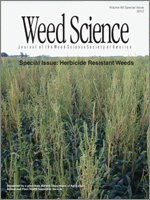This special issue of Weed Science is the result of collaboration between the U.S. Department of Agriculture (USDA) Animal and Plant Health Inspection Service (APHIS; the federal agency responsible for regulating genetically engineered crops) and the Weed Science Society of America (WSSA). It is the product of more than 3 yr of work by two groups of WSSA members. The first group was charged with writing a comprehensive manuscript containing background information on the evolution of herbicide resistance in weed species. The second group was charged with assessing best-management practices and policies to combat the further evolution and spread of herbicide-resistant weeds. This issue is intended to serve not only the weed science discipline but also, and perhaps, more important, the broader community that is faced with addressing this problem.
Herbicide resistance in weeds has become one of the most pressing issues facing weed scientists, agricultural producers, and land managers, in general. This problem has received widespread attention with the evolution of glyphosate-resistant weeds in glyphosate-resistant (GR) crops. However, this problem far predates glyphosate resistance. In fact, the introduction of GR crops was initially seen as a solution to weed resistance to other herbicides, such as the acetolactate synthase inhibitors, which was becoming a national, and even international, crisis in agriculture.
Federal agencies, the agrochemical industry, nongovernmental organizations, farm commodity groups, and academia are engaging in an unprecedented dialog on how best to preserve rare and invaluable herbicide technologies and soil-protecting cropping systems in the face of rapidly expanding herbicide resistance. The interests behind this goal are quite diverse; for example, the USDA Natural Resources Conservation Service is vitally interested in preventing the abandonment of conservation tillage practices because of problems with controlling herbicide-resistant weeds. Additionally, the Environmental Protection Agency is responsible for pesticide stewardship, and it is actively seeking proactive educational programs, rather than mandating specific weed management practices through regulatory actions, as a means to promote sound and sustainable herbicide use.
APHIS approached the WSSA in 2008 with a request to develop comprehensive background information on herbicide resistance. The purpose of this cooperative effort was to promote a common understanding of how the evolution of herbicide-resistant weeds was linked to herbicide use and the introduction of genetically engineered herbicide-resistant crops. In addition, APHIS wanted information on how the use of herbicides in agroecosystems was causing shifts in weed populations. The report was to outline the state of knowledge on the evolution, management, and impact of herbicide-resistant weeds and weed population shifts in both conventional and genetically engineered crops. It was designed as an informational tool for the general public, federal agencies, companies, and other interested entities involved in the assessment of the effects on environments and in the evolution of herbicide-resistance management strategies. As such, it was to cover fundamental aspects of the biology, ecology, and physiology of weeds and herbicides as tools for weed management at a level understandable by nonweed scientists.
As this report was under development, APHIS asked the WSSA to write a second report focused on documenting the current use and success of herbicide-resistance management programs in various agroecosystems, focusing on single-season row crops and orchards. To accomplish this task, four questions were identified: (1) What methods are being currently used to manage the spread and evolution of herbicide resistance in weeds? (2) How effective are these methods and how widely are they being used? (3) Why are these methods being or not being adopted? and, (4) What, if anything, can be done to increase the use of integrated herbicide-resistance management programs?
In evaluating and answering these questions, APHIS sought to understand the effectiveness of both individual methods and combinations of the methods. APHIS hoped that the outcome of this project would be the identification of implementable, proven, and effective measures to manage the spread of herbicide-resistant weeds. The agency would use this information to promote effective methods for controlling or slowing the selection of herbicide-resistant weeds, to address resistance management in environmental analyses under the National Environmental Policy Act, and to inform risk assessment and risk management. APHIS specified that the two reports be published via Open Access in a readily available scientific journal. The following two articles were developed from these two separate, but closely related, efforts.
In recognition of the importance of this topic, the Weed Science Society of America adopted the Executive Summary of “Reducing the Risks of Herbicide Resistance: Best Management Practices and Recommendations” as an official position paper for the Society.





